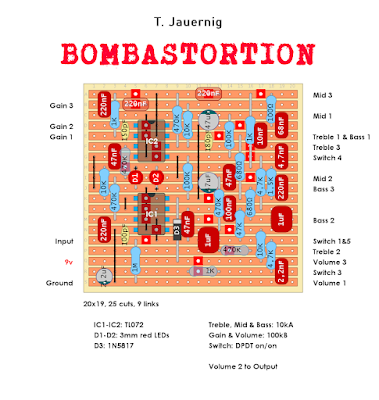Schematic is avaiable HERE.
Dirtbox Layouts
Wednesday, 9 July 2025
Friday, 4 July 2025
Wednesday, 25 June 2025
Tuesday, 10 June 2025
Saturday, 7 June 2025
Wednesday, 4 June 2025
Tuesday, 3 June 2025
Sunday, 25 May 2025
Saturday, 10 May 2025
Friday, 9 May 2025
Friday, 18 April 2025
Sunday, 13 April 2025
Saturday, 12 April 2025
Sprinklesounds Mot(not)onous
Here is a contribution from Jordan Fontaine, a modified Mid-Fi Clarinot)
Modded Midfi Clari(not)
This was a fun project to delve into. I certainly didn’t stay true to the short delay, tape warble aesthetic. The delay still does that sound but now it can run wild too. Very versatile now for rockabilly, dub, shoegaze etc.
Delay time is extended and feedback added to extend beyond a single repeat.
The trimmer sets the threshold for runaway repeats to taste.
I borrowed the blend for Midfi’s Pitch Pirate so there are more sounds available here.
If you have runaway repeats happening and dial the blend close to dry it almost sounds like a scratchy record under your playing.
The fuzz control from the original has been removed to add to the ‘clean’ sound of the pedal. Although the longer repeats will add noise and clip as well.
Where the crazy comes in is the external mounted LDR. The second footswitch engages the LDR and affects the Delay control as you interfere with the light in front of it. The Offset control allows for the light to make dramatic or subtle changes to the time. This is easily omitted if you're not interested in it.
















onous%20-%20SprinkleSounds.png)


